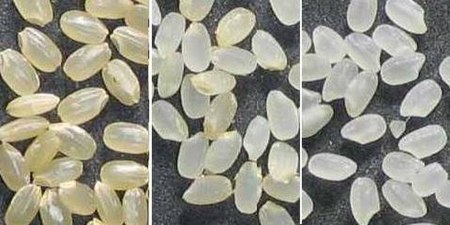Rice


Riceis acereal grainand in itsdomesticatedform is thestaple foodof over half of theworld's population,particularly inAsiaandAfrica.Rice is the seed of the grass speciesOryza sativa(Asian rice)—or, much less commonly,Oryza glaberrima(African rice). Asian rice was domesticated inChinasome 13,500 to 8,200 years ago; African rice was domesticated in Africa about 3,000 years ago. Rice has become commonplace in many cultures worldwide; in 2021, 787 million tons were produced, placing it fourth aftersugarcane,maize,andwheat.Only some 8% of rice is traded internationally. China, India, and Indonesia are the largest consumers of rice. A substantial amount of the rice produced in developing nations is lost after harvest through factors such as poor transport and storage. Rice yields can be reduced by pests includinginsects,rodents,andbirds,as well as byweeds,and bydiseasessuch asrice blast.Traditionalrice polyculturessuch asrice-duck farming,and modernintegrated pest managementseek to control damage from pests in asustainableway.
Many varieties of rice have been bred to improve crop quality and productivity.Biotechnologyhas createdGreen Revolutionrice able to produce high yields when supplied withnitrogen fertiliserand managed intensively. Other products are rice able to express human proteins for medicinal use; flood-tolerant ordeepwater rice;and drought-tolerant andsalt-tolerantvarieties. Rice is used as amodel organismin biology.
Dry rice grain is milled to remove the outer layers; depending on how much is removed, products range from brown rice to rice with germ and white rice. Some isparboiledto make it easy to cook. Rice contains nogluten;it providesproteinbut not all theessential amino acidsneeded for good health. Rice of different types is eaten around the world. Long-grain rice tends to stay intact on cooking; medium-grain rice is stickier, and is used for sweet dishes, and in Italy forrisotto;and sticky short-grain rice is used in Japanesesushias it keeps its shape when cooked. White rice when cooked contains 29%carbohydrateand 2% protein, with somemanganese.Golden riceis a variety produced bygenetic engineeringto containvitamin A.
Production of rice is estimated to have caused over 1% of globalgreenhouse gas emissionsin 2022. Predictions of how rice yields will be affected by climate change vary across geographies and socioeconomic contexts. In human culture, rice plays a role in various religions and traditions, such as inweddings.
Description
The rice plant can grow to over 1 m (3 ft) tall; if in deep water, it can reach a length of 5 m (16 ft). A single plant may have several leafy stems ortillers.The upright stem is jointed withnodesalong its length; a long slender leaf arises from each node.[1]Theself-fertileflowers are produced in apanicle,a branchedinflorescencewhich arises from the last internode on the stem. There can be up to 350spikeletsin a panicle, each containing male and female flower parts (anthersandovule). A fertilised ovule develops into the edible grain orcaryopsis.[2]
Rice is a cereal belonging to the familyPoaceae.As atropicalcrop, it can be grown during the two distinct seasons (dry and wet) of the year provided that sufficient water is made available.[3]It is normally an annual, but in the tropics it can survive as aperennial,producing aratooncrop.[4]
Agronomy
Growing
Like all crops, rice depends for its growth on both biotic and abiotic environmental factors. The principal biotic factors are crop variety,pests,andplant diseases.Abiotic factors include the soil type, whether lowland or upland, amount of rain or irrigation water, temperature,day length,and intensity of sunlight.[5]
Rice grains can be planted directly into the field where they will grow, or seedlings can be grown in a seedbed and transplanted into the field. Direct seeding needs some 60 to 80 kg of grain per hectare, while transplanting needs less, around 40 kg per hectare, but requires far more labour.[6]Most rice in Asia is transplanted by hand. Mechanical transplanting takes less time but requires a carefully-prepared field and seedlings raised on mats or in trays to fit the machine.[7]Rice does not thrive if continuously submerged.[8]Rice can be grown in different environments, depending upon water availability. The usual arrangement is for lowland fields to be surrounded bybundsand flooded to a depth of a few centimetres until around a week before harvest time; this requires a large amount of water. The "alternate wetting and drying" technique uses less water. One form of this is to flood the field to a depth of 5 cm (2 in), then to let the water level drop to 15 cm (6 in) below surface level, as measured by looking into a perforated field water tube sunk into the soil, and then repeating the cycle.[9]Deepwater ricevarieties tolerate flooding to a depth of over 50 centimetres for at least a month.[10]Upland riceis grown without flooding, in hilly or mountainous regions; it israinfedlike wheat or maize.[11]
-
Ploughing a rice terrace withwater buffaloesinJava
-
Farmers planting rice by hand inCambodia
-
Mechanised rice planting in Japan
-
Ancient mountainsiderice terraces at Banaue,Philippines
Harvesting
Across Asia, unmilled rice or "paddy" (Indonesian and Malaypadi), was traditionally the product ofsmallholderagriculture, with manualharvesting.Larger farms make use of machines such ascombine harvestersto reduce the input of labour.[12]The grain is ready to harvest when the moisture content is 20–25%. Harvesting involvesreaping,stacking the cut stalks,threshingto separate the grain, and cleaning bywinnowingorscreening.[13]The rice grain is dried as soon as possible to bring the moisture content down to a level that is safe from mould fungi. Traditional drying relies on the heat of the sun, with the grain spread out on mats or on pavements.[14]
-
Ricecombine harvesterinChiba Prefecture,Japan
-
After the harvest, rice straw is gathered in the traditional way from small paddy fields inMae Wang,Thailand
-
Drying rice inPeravoor,India
Evolution
Phylogeny
The edible rice species are members of theBOP cladewithin the grass family, thePoaceae.The rice subfamily,Oryzoideae,is sister to the bamboos,Bambusoideae,and the cereal subfamilyPooideae.The rice genusOryzais one of eleven in the Oryzeae; it is sister to thePhyllorachideae.The edible rice speciesO. sativaandO. glaberrimaare among some 300 species or subspecies in the genus.[15]
| Poaceae |
| |||||||||||||||||||||||||||||||||||||||||||||||||||||||||
History

Oryza sativarice was firstdomesticatedinChina9,000 years ago,[16]by people ofNeolithiccultures in theUpperandLower Yangtze,associated withHmong-Mien-speakers andpre-Austronesians,respectively.[17][18][19][20]The functionalallelefornonshattering,the critical indicator of domestication in grains, as well as five othersingle-nucleotide polymorphisms,is identical in bothindicaandjaponica.This implies a single domestication event forO. sativa.[21]Bothindicaandjaponicaforms of Asian rice sprang from a single domestication event in China from the wild riceOryza rufipogon.[22][21]Despite this evidence, it appears thatindicarice arose whenjaponicaarrived in India about 4,500 years ago and hybridised with another rice, whether an undomesticated proto-indicaor wildO. nivara.[23]
Rice was introduced early intoSino-Tibetancultures in northern China by around 6000 to 5600 years ago,[24][25][18]and to theKoreanpeninsula andJapanby around 5500 to 3200 years ago.[26][27]It was also carried intoTaiwanby theDapenkengculture by 5500 to 4000 years ago, before spreading southwards via theAustronesian migrationstoIsland Southeast Asia,Madagascar,andGuam,but did not survive the voyage to the rest of the Pacific.[17][28][29]It reachedAustroasiaticandKra-Dai-speakers inMainland Southeast Asiaand southern China by 5000 years ago.[17][30]
Rice spread around the rest of the world through cultivation, migration and trade, eventually to the Americas as part of theColumbian exchangeafter 1492.[31]The now less commonOryza glaberrima(African rice) was independently domesticated in Africa around 3,000 years ago,[31]and introduced to the Americas by the Spanish.[32]InBritish North Americaby the time of the start of theAmerican War of Independence,rice had become the fourth most valuable export commodity behind only tobacco, wheat, and fish.[33]
Commerce
| Rice production – 2021 | |
|---|---|
| Country | Millions oftonnes |
| 213 | |
| 195 | |
| 57 | |
| 54 | |
| 44 | |
| 30 | |
| World | 787[34] |
Production
In 2021, world production of rice was 787 milliontonnes,led by China and India with a combined 52% of the total.[34]This placed rice fourth in the list of crops by production, aftersugarcane,maize,andwheat.[35]Other major producers wereBangladesh,IndonesiaandVietnam.[35]90% of world production is from Asia.[36]
-
Production of rice (2021)[35]
-
Since 2000, rice production (orange) has increased,
but its share of total crop production has fallen.
Yield records
The average world yield for rice was 4.7 metric tons per hectare (2.1 short tons per acre), in 2022.[37]Yuan Longpingof China's National Hybrid Rice Research and Development Center set a world record for rice yield in 1999 at 17.1 metric tons per hectare (7.6 short tons per acre) on a demonstration plot. This employed specially developed hybrid rice and theSystem of Rice Intensification(SRI), an innovation in rice farming.[38]
Food security
Rice is a major food staple in Asia, Latin America, and some parts of Africa,[39]feeding over half the world's population.[36]However, a substantial part of the crop can be lost post-harvest through inefficient transportation, storage, and milling. A quarter of the crop in Nigeria is lost after harvest. Storage losses include damage bymouldfungi if the rice is not dried sufficiently. In China, losses in modern metalsiloswere just 0.2%, compared to 7–13% when rice was stored by rural households.[40]
Processing
The dry grain is milled to remove the outer layers, namely thehuskandbran.These can be removed in a single step, in two steps, or as in commercial milling in a multi-step process of cleaning, dehusking, separation, polishing, grading, and weighing.[41]Brown rice only has the inedible husk removed.[42]Further milling removes bran and the germ to create successively whiter products.[42]Parboiled riceis subjected to a steaming process before it is milled. This makes the grain harder, and moves some of the grain'svitaminsandmineralsinto the white part of the rice so these are retained after milling.[42]Rice does not containgluten,so is suitable for people on agluten-free diet.[43]Rice is a good source of protein and a staple food in many parts of the world, but it is not acomplete proteinas it does not contain all of theessential amino acidsin sufficient amounts for good health.[44]
-
Rice processingremoves one or more layers to create marketable products.
A: Rice withchaff
B:Brown rice
C: Rice withgerm
D:White ricewithbranresidue
E: Polished
(1):Chaff
(2):Bran
(3): Branresidue
(4):Cereal germ
(5):Endosperm
Trade
World trade figures are much smaller than those for production, as less than 8% of rice produced is traded internationally. China, an exporter of rice in the early 2000s, had become the world's largest importer of rice by 2013.[45]Developing countries are the main players in the world rice trade; by 2012, India was the largest exporter of rice, with Thailand and Vietnam the other largest exporters.[46]
Worldwide consumption
As of 2016, the countries that consumed the most rice were China (29% of total), India, and Indonesia.[47]By 2020, Bangladesh had taken third place from Indonesia. On an annual average from 2020-23, China consumed 154 million tonnes of rice, India consumed 109 million tonnes, and Bangladesh and Indonesia consumed about 36 million tonnes each. Across the world, rice consumption per capita fell in the 21st century as people in Asia and elsewhere ate less grain and more meat. An exception is Sub-Saharan Africa, where both per capita consumption of rice and population are increasing.[48]
Food
| Nutritional value per 100 g (3.5 oz) | |||||||||||||||||||||||||||||||||||||||||
|---|---|---|---|---|---|---|---|---|---|---|---|---|---|---|---|---|---|---|---|---|---|---|---|---|---|---|---|---|---|---|---|---|---|---|---|---|---|---|---|---|---|
| Energy | 544 kJ (130 kcal) | ||||||||||||||||||||||||||||||||||||||||
28.6 g | |||||||||||||||||||||||||||||||||||||||||
0.2 g | |||||||||||||||||||||||||||||||||||||||||
2.4 g | |||||||||||||||||||||||||||||||||||||||||
| |||||||||||||||||||||||||||||||||||||||||
| Other constituents | Quantity | ||||||||||||||||||||||||||||||||||||||||
| Water | 69 g | ||||||||||||||||||||||||||||||||||||||||
| †Percentages estimated usingUS recommendationsfor adults,[49]except for potassium, which is estimated based on expert recommendation fromthe National Academies.[50] | |||||||||||||||||||||||||||||||||||||||||
Eating qualities
Rice is a commonly-eaten food around the world. Thevarieties of riceare typically classified as short-, medium-, and long-grained.Oryza sativa indicavarieties are usually long-grained;Oryza sativa japonicavarieties are usually short- or medium-grained. Short-grain rice, with the exception of Spanish Bomba, is usually sticky when cooked, and is suitable for puddings. ThaiJasmine riceis aromatic, and unusually for a long-grain rice has some stickiness, with a soft texture. IndianBasmati riceis very long-grained and aromatic. ItalianArborio rice,used forrisotto,is of medium length, oval, and quite sticky. Japanesesushirice is a sticky short-grain variety.[51]
Nutrition
Cooked white rice is 69% water, 29%carbohydrates,2%protein,and contains negligiblefat(table). In a reference serving of 100 grams (3.5 oz), cooked white rice provides 130caloriesoffood energy,and contains moderate levels ofmanganese(18% DV), with no othermicronutrientsin significant content (all less than 10% of theDaily Value).[52] In 2018, theWorld Health Organizationstrongly recommendedfortifyingrice withiron,and conditionally recommended fortifying it withvitamin Aand withfolic acid.[53]
Golden rice
Golden rice is a variety produced throughgenetic engineeringto synthesizebeta-carotene,a precursor of vitamin A, in theendospermof the rice grain. It is intended to be grown and eaten in parts of the world whereVitamin A deficiencyis prevalent.[54][55]Golden rice has been opposed by activists, such as in thePhilippines.[56]In 2016 more than 100Nobel laureatesencouraged the use ofgenetically modified organisms,such as golden rice, for the benefits these could bring.[57]
Rice and climate change
Greenhouse gases from rice production

In 2022,greenhouse gas emissionsfrom rice cultivation were estimated at 5.7 billion tonnes CO2eq, representing 1.2% of total emissions.[58]Within the agriculture sector, rice produces almost half the greenhouse gas emissions fromcroplands,[59]some 30% of agriculturalmethane emissions,and 11% of agriculturalnitrous oxideemissions.[60]Methaneis released from rice fields subject to long-term flooding, as this inhibits the soil from absorbing atmospheric oxygen, resulting inanaerobic fermentationof organic matter in the soil.[61]Emissions can be limited by planting new varieties, not flooding continuously, and removing straw.[62]
It is possible to cut methane emissions in rice cultivation by improved water management, combining dry seeding and one drawdown, or executing a sequence of wetting and drying. This results in emission reductions of up to 90% compared to full flooding and even increased yields.[63]
Effects of climate change on rice production
Predictions of climate change's effects on rice cultivation vary. Global rice yield has been projected to decrease by around 3.2% with each 1°C increase in global average temperature[64]while another study predicts global rice cultivation will increase initially, plateauing at about 3°C warming (2091–2100 relative to 1850–1900).[65]
The impacts of climate change on rice cultivation vary across geographic location and socioeconomic context. For example, rising temperatures and decreasing solar radiation during the later years of the 20th century decreased rice yield by between 10% and 20% across 200 farms in seven Asian countries. This may have been caused by increased night-time respiration.[66][67]IRRI has predicted that Asian rice yields will fall by some 20% per 1°C rise in global mean temperature. Further, rice is unable to yield grain if the flowers experience a temperature of 35 °C or more for over one hour, so the crop would be lost under these conditions.[68][69]
In thePo Valleyin Italy, thearborioandcarnarolirisotto rice varieties have suffered poor harvests through drought in the 21st century. TheEnte Nazionale Risiis developing drought-resistant varieties; itsnuovo prometeovariety has deep roots that enable it to tolerate drought, but is not suitable for risotto.[70]
Pests, weeds, and diseases
Pests and weeds
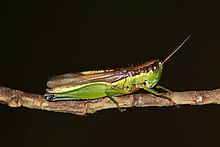
Rice yield can be reduced by weed growth, and a wide variety of pests including insects, nematodes, rodents such as rats, snails, and birds.[71]Major rice insect pests include armyworms,rice bugs,black bugs,cutworms, field crickets, grasshoppers, leafhoppers, mealybugs, and planthoppers.[72]High rates ofnitrogen fertiliserapplication may worsen aphid outbreaks.[73] Weather conditions can contribute to pest outbreaks:rice gall midgeoutbreaks are worsened by high rainfall in the wet season, whilethripsoutbreaks are associated with drought.[74]
Diseases
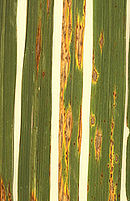
Rice blast,caused by the fungusMagnaporthe grisea,is the most serious disease of growing rice.[75] It andbacterial leaf streak(caused byXanthomonas oryzaepv.oryzae) are perennially the two worst rice diseases worldwide; they are both among the ten most important diseases of all crop plants.[76]Other major rice diseases includesheath blight(caused byRhizoctonia solani), false smut (Ustilaginoidea virens), and bacterial panicle blight (Burkholderia glumae).[76]Viral diseases include rice bunchy stunt, rice dwarf, ricetungro,and rice yellow mottle.[77]
Pest management
Crop protectionscientists are developingsustainabletechniques for managing rice pests.[78]Sustainable pest management is based on four principles: biodiversity, host plant resistance, landscape ecology, and hierarchies in a landscape—from biological to social.[79]Farmers' pesticide applications are often unnecessary.[80]Pesticides may actually induceresurgenceof populations of rice pests such as thebrown planthopper,both by destroying beneficial insects and by enhancing the pest's reproduction.[81]TheInternational Rice Research Institute(IRRI) demonstrated in 1993 that an 87.5% reduction in pesticide use can lead to an overall drop in pest numbers.[82]

Farmers in China, Indonesia and the Philippines have traditionally managed weeds and pests by thepolyculturalpractice ofraising ducksandsometimes fishin their rice paddies. These produce valuable additional crops, eat small pest animals, manure the rice, and in the case of ducks also control weeds.[83][84]
Rice plants produce their own chemical defences to protect themselves from pest attacks. Some synthetic chemicals, such as the herbicide2,4-D,cause the plant to increase the production of certain defensive chemicals and thereby increase the plant's resistance to some types of pests.[85]Conversely, other chemicals, such as the insecticideimidacloprid,appear to induce changes in the gene expression of the rice that make the plant more susceptible to certain pests.[86]
Plant breeders have created rice cultivars incorporatingresistance to various insect pests.Conventional plant breeding of resistant varieties has been limited by challenges such as rearing insect pests for testing, and the great diversity and continuous evolution of pests. Resistance genes are being sought from wild species of rice, and genetic engineering techniques are being applied.[87]
Ecotypes and cultivars

TheInternational Rice Research Institutemaintains the International Rice Genebank, which holds over 100,000 rice varieties.[88][89]Much of southeast Asia growsstickyor glutinous rice varieties.[90]High-yield cultivars of rice suitable for cultivation in Africa, called theNew Rice for Africa(NERICA), have been developed to improvefood securityand alleviate poverty in Sub-Saharan Africa.[91]
The completegenomeof rice wassequencedin 2005, making it the first crop plant to reach this status.[92] Since then, the genomes of hundreds of types of rice, both wild and cultivated, and including both Asian and African rice species, have been sequenced.[93]
Biotechnology
High-yielding varieties
The high-yielding varieties are a group of crops created during theGreen Revolutionto increase global food production radically. The first Green Revolution rice variety,IR8,was produced in 1966 at theInternational Rice Research Institutethrough a cross between an Indonesian variety named "Peta" and a Chinese variety named "Dee Geo Woo Gen".[94]Green Revolution varieties were bred to have short strong stems so that the rice would not lodge or fall over. This enabled them to stay upright and productive even with heavy applications of fertiliser.[94]
Expression of human proteins
Ventria Biosciencehasgenetically modifiedrice toexpresslactoferrinandlysozymewhich areproteinsusually found inbreast milk,andhuman serum albumin.These proteins haveantiviral,antibacterial,andantifungaleffects.[95]Rice containing these added proteins can be used as a component inoral rehydration solutionsto treatdiarrhealdiseases, thereby shortening their duration and reducing recurrence. Such supplements may also help reverseanemia.[96]
Flood-tolerance
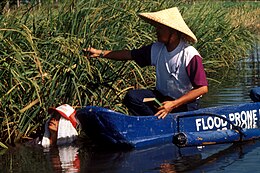
In areas subject toflooding,farmers have long planted flood tolerant varieties known asdeepwater rice.In South andSouth East Asia,flooding affects some 20 million hectares (49 million acres) each year.[97] Flooding has historically led to massive losses in yields, such as in the Philippines, where in 2006, rice crops worth $65 million were lost to flooding.[98]
Standard rice varieties cannot withstand stagnant flooding for more than about a week, since it disallows the plant access to necessary requirements such as sunlight and gas exchange. The Swarna Sub1 cultivar can tolerate week-long submergence, consuming carbohydrates efficiently and continuing to grow.[97]So-called "scubarice "[99]with the Sub1Atransgeneis robustly tolerant of submergence for as long as two weeks, offering much improved flood survival for farmers' crops. IRRI has created Sub1A varieties and distributed them to Bangladesh, India, Indonesia, Nepal, and the Philippines.[100]
Drought-tolerance
Droughtrepresents a significant environmental stress for rice production, with 19–23 million hectares (47–57 million acres) of rainfed rice production in South and South East Asia often at risk.[101][102]Under drought conditions, without sufficient water to afford them the ability to obtain the required levels ofnutrientsfrom the soil, conventional commercial rice varieties can be severely affected—as happened for example in India early in the 21st century.[103]
TheInternational Rice Research Instituteconducts research into developing drought-tolerant rice varieties, including the varieties Sahbhagi Dhan, Sahod Ulan, and Sookha dhan, currently being employed by farmers in India, the Philippines, and Nepal respectively.[102]In addition, in 2013 the Japanese National Institute for Agrobiological Sciences led a team which successfully inserted theDEEPER ROOTING 1(DRO1) gene, from the Philippineuplandrice variety Kinandang Patong, into the popular commercial rice variety IR64, giving rise to a far deeper root system in the resulting plants.[103]This facilitates an improved ability for the rice plant to derive its required nutrients in times of drought via accessing deeper layers ofsoil,a feature demonstrated by trials which saw the IR64 + DRO1 rice yields drop by 10% under moderate drought conditions, compared to 60% for the unmodified IR64 variety.[103][104]
Salt-tolerance
Soil salinityposes a major threat to rice crop productivity, particularly along low-lying coastal areas during the dry season.[101][105]For example, roughly 1 million hectares (2.5 million acres) of the coastal areas ofBangladeshare affected by saline soils.[106]These high concentrations of salt can severely affect rice plants'physiology,especially during early stages of growth, and as such farmers are often forced to abandon these areas.[107]
Progress has been made in developing rice varieties capable of tolerating such conditions; the hybrid created from the cross between the commercial rice variety IR56 and the wild rice speciesOryza coarctatais one example.[108]O. coarctatacan grow in soils with double the limit of salinity of normal varieties, but does not produce edible rice.[108]Developed by theInternational Rice Research Institute,thehybridvariety utilises specialised leaf glands that remove salt into the atmosphere. It was produced from one successfulembryoout of 34,000 crosses between the two species; this was thenbackcrossedto IR56 with the aim of preserving the genes responsible for salt tolerance that were inherited fromO. coarctata.[107]
Cold tolerance
Rice is sensitive to temperatures below 12C. Sowing takes place once the daily average temperature is reliably above this limit. Average temperatures below that reduce growth; if sustained for over four days, germination and seedling growth are harmed and seedlings may die. In larger plants subjected to cold, rice blast is encouraged, seriously reducing yield. As of 2022, researchers continue to study the mechanisms of chilling tolerance in rice and its genetic basis.[109]
Reducing methane emissions
Producing rice inpaddiesis harmful for the environment due to the release of methane bymethanogenic bacteria.These bacteria live in the anaerobic waterlogged soil, consuming nutrients released by rice roots. Putting thebarleygeneSUSIBA2into rice creates a shift in biomass production from root to shoot, decreasing the methanogen population, and resulting in a reduction of methane emissions of up to 97%. Further, the modification increases the amount of rice grains.[110][111]
Model organism
Rice is used as amodel organismfor investigating the mechanisms ofmeiosisandDNA repairin higher plants.[112]For example, study using rice has shown that the geneOsRAD51Cis necessary for the accurate repair of DNA double-strand breaks during meiosis.[113]
In human culture

Rice plays an important role in certain religions and popular beliefs. In Hindu wedding ceremonies, rice, denoting fertility, prosperity, and purity, is thrown into the sacred fire, a custom modified in Western weddings, where people throw rice.[114]In Malay weddings, rice features in multiple special wedding foods such as sweet glutinous rice.[115]In Japan and the Philippines, rice wine is used for weddings and other celebrations.[116]Dewi Sriis a goddess of the Indo-Malaysian archipelago, who in myth is transformed into rice or other crops.[117]The start of the rice planting season is marked in Asian countries including Nepal and Cambodia with aRoyal Ploughing Ceremony.[118][119][120]
See also
References
- ^"Oryza sativa L."Royal Botanic Gardens, Kew.RetrievedDecember 6,2023.
- ^"The Rice Plant".Rice Hub.RetrievedDecember 6,2023.
- ^Kawure, S.; Garba, A.A.; Fagam, A.S.; Shuaibu, Y.M.; Sabo, M.U.; Bala, R.A. (December 31, 2022)."Performance of Lowland Rice (Oryza sativa L.) as Influenced by Combine Effect of Season and Sowing Pattern in Zigau".Journal of Rice Research and Developments.5(2).doi:10.36959/973/440.
- ^"The Rice Plant and How it Grows".International Rice Research Institute.Archived fromthe originalon January 6, 2009.
- ^Beighley, Donn H. (2010). "Growth and Production of Rice". In Verheye, Willy H. (ed.).Soils, Plant Growth and Crop Production Volume II.EOLSSPublishers. p. 49.ISBN978-1-84826-368-0.
- ^"How to plant rice".International Rice Research Institute.RetrievedDecember 29,2023.
- ^"Transplanting".International Rice Research Institute.RetrievedDecember 29,2023.
- ^Uphoff, Norman."More rice with less water through SRI - the System of Rice Intensification"(PDF).Cornell University.Archived fromthe original(PDF)on December 26, 2011.RetrievedMay 13,2012.
- ^"Water Management".International Rice Research Institute.RetrievedNovember 4,2023.
- ^Catling, David (1992)."Deepwater Rice Cultures in the Ganges-Brahmaputra Basin".Rice in Deep Water.International Rice Research Institute.p. 2.ISBN978-971-22-0005-2.
- ^Gupta, Phool Chand; O'Toole, J. C. O'Toole (1986).Upland Rice: A Global Perspective.International Rice Research Institute.ISBN978-971-10-4172-4.
- ^"Harvesting systems".International Rice Research Institute.RetrievedJanuary 3,2024.
- ^"Harvesting".International Rice Research Institute.RetrievedDecember 6,2023.
- ^"Drying".International Rice Research Institute.RetrievedDecember 6,2023.
- ^Soreng, Robert J.; Peterson, Paul M.; Romaschenko, Konstantin; Davidse, Gerrit; Teisher, Jordan K.; Clark, Lynn G.; Barberá, Patricia; Gillespie, Lynn J.; Zuloaga, Fernando O. (2017)."A worldwide phylogenetic classification of the Poaceae (Gramineae) II: An update and a comparison of two 2015 classifications".Journal of Systematics and Evolution.55(4): 259–290.doi:10.1111/jse.12262.hdl:10261/240149.
- ^Fornasiero, Alice; Wing, Rod A.; Ronald, Pamela (January 2022). "Rice domestication".Current Biology.32(1): R20–R24.Bibcode:2022CBio...32..R20F.doi:10.1016/j.cub.2021.11.025.PMID35015986.
- ^abcBellwood, Peter (December 2011)."The Checkered Prehistory of Rice Movement Southwards as a Domesticated Cereal—from the Yangzi to the Equator".Rice.4(3–4): 93–103.Bibcode:2011Rice....4...93B.doi:10.1007/s12284-011-9068-9.
- ^abHe, Keyang; Lu, Houyuan; Zhang, Jianping; Wang, Can; Huan, Xiujia (December 2017). "Prehistoric evolution of the dualistic structure mixed rice and millet farming in China".The Holocene.27(12): 1885–1898.doi:10.1177/0959683617708455.
- ^Hsieh, Jaw-shu; Hsing, Yue-ie Caroline; Hsu, Tze-fu; Li, Paul Jen-kuei; Li, Kuang-ti; Tsang, Cheng-hwa (December 24, 2011)."Studies on Ancient Rice—Where Botanists, Agronomists, Archeologists, Linguists, and Ethnologists Meet".Rice.4(3–4): 178–183.Bibcode:2011Rice....4..178H.doi:10.1007/s12284-011-9075-x.
- ^Chi, Zhang; Hung, Hsiao-Chun (2008). "The Neolithic of Southern China—Origin, Development, and Dispersal".Asian Perspectives.47(2): 299–329.doi:10.1353/asi.0.0004.hdl:10125/17291.JSTOR42928744.GaleA191316867Project MUSE257900.
- ^abVaughan, Duncan A.; Lu, Bao-Rong; Tomooka, Norihiko (April 2008). "The evolving story of rice evolution".Plant Science.174(4): 394–408.doi:10.1016/j.plantsci.2008.01.016.
- ^Molina, J.; Sikora, M.; Garud, N.; Flowers, J. M.; Rubinstein, S.; et al. (2011)."Molecular evidence for a single evolutionary origin of domesticated rice".Proceedings of the National Academy of Sciences.108(20): 8351–8356.Bibcode:2011PNAS..108.8351M.doi:10.1073/pnas.1104686108.PMC3101000.PMID21536870.
- ^Choi, Jae; et al. (2017)."The Rice Paradox: Multiple Origins but Single Domestication in Asian Rice".Molecular Biology and Evolution.34(4): 969–979.doi:10.1093/molbev/msx049.PMC5400379.PMID28087768.
- ^Zhang, Jianping; Lu, Houyuan; Gu, Wanfa; Wu, Naiqin; Zhou, Kunshu; et al. (December 17, 2012)."Early Mixed Farming of Millet and Rice 7800 Years Ago in the Middle Yellow River Region, China".PLOS ONE.7(12): e52146.Bibcode:2012PLoSO...752146Z.doi:10.1371/journal.pone.0052146.PMC3524165.PMID23284907.
- ^Fuller, Dorian Q. (December 2011)."Pathways to Asian Civilizations: Tracing the Origins and Spread of Rice and Rice Cultures".Rice.4(3–4): 78–92.Bibcode:2011Rice....4...78F.doi:10.1007/s12284-011-9078-7.
- ^Crawford; Shen (1998). "The Origins of rice agriculture: recent progress in East Asia".Antiquity.72(278): 858–866.doi:10.1017/S0003598X00087494.S2CID162486123.
- ^Crawford, G. W. & Lee, G.-A. (March 2003). "Agricultural Origins in the Korean Peninsula".Antiquity.77(295): 87–95.doi:10.1017/s0003598x00061378.S2CID163060564.
- ^Beaujard, Philippe (August 2011)."The first migrants to Madagascar and their introduction of plants: linguistic and ethnological evidence"(PDF).Azania: Archaeological Research in Africa.46(2): 169–189.doi:10.1080/0067270X.2011.580142.
- ^Carson, Mike T. (2012)."An overview of latte period archaeology"(PDF).Micronesica.42(1/2): 1–79.Archived(PDF)from the original on April 12, 2019.RetrievedJanuary 25,2019.
- ^Higham, Charles F. W.; Douka, Katerina; Higham, Thomas F. G.; Hart, John P. (September 18, 2015)."A New Chronology for the Bronze Age of Northeastern Thailand and Its Implications for Southeast Asian Prehistory".PLOS ONE.10(9): e0137542.Bibcode:2015PLoSO..1037542H.doi:10.1371/journal.pone.0137542.PMC4575132.PMID26384011.
- ^abChoi, Jae Young (March 7, 2019)."The complex geography of domestication of the African rice Oryza glaberrima".PLOS Genetics.15(3): e1007414.doi:10.1371/journal.pgen.1007414.PMC6424484.PMID30845217.
- ^National Research Council (1996)."African Rice".Lost Crops of Africa: Volume I: Grains.Vol. 1.National Academies Press.doi:10.17226/2305.ISBN978-0-309-04990-0.Archivedfrom the original on January 22, 2009.RetrievedJuly 18,2008.
- ^Morgan, Kenneth (July 1995). "The Organization of the Colonial American Rice Trade".The William and Mary Quarterly.52(3): 433–452.doi:10.2307/2947294.JSTOR2947294.
- ^ab"Rice production in 2021; Crops/Regions/World list/Production Quantity/Year (from pick lists)".FAOSTAT,UN Food and Agriculture Organization, Corporate Statistical Database. 2023.RetrievedDecember 4,2023.
- ^abcWorld Food and Agriculture – Statistical Yearbook 2021.United NationsFood and Agriculture Organization.2021.doi:10.4060/cb4477en.ISBN978-92-5-134332-6.S2CID240163091.RetrievedDecember 10,2021.
- ^abFukagawa, Naomi K.; Ziska, Lewis H. (October 11, 2019)."Rice: Importance for Global Nutrition".Journal of Nutritional Science and Vitaminology.65(Supplement): S2–S3.doi:10.3177/jnsv.65.S2.PMID31619630.
- ^"FAOSTAT: Production-Crops, 2022 data".United NationsFood and Agriculture Organization.2022. Archived fromthe originalon June 19, 2012.RetrievedJanuary 12,2012.
- ^Yuan, Longping(2010)."A Scientist's Perspective on Experience with SRI in China for Raising the Yields of Super Hybrid Rice"(PDF).Cornell University.Archived fromthe original(PDF)on November 20, 2011.
- ^"Food Staple".National GeographicEducation.RetrievedDecember 6,2023.
- ^Kumar, Deepak; Kalita, Prasanta (January 15, 2017)."Reducing Postharvest Losses during Storage of Grain Crops to Strengthen Food Security in Developing Countries".Foods.6(1): 8.doi:10.3390/foods6010008.PMC5296677.PMID28231087.
- ^"Milling".International Rice Research Institute.RetrievedJanuary 4,2024.
- ^abc"Types of rice".Rice Association. Archived fromthe originalon August 2, 2018.RetrievedAugust 2,2018.
- ^Penagini, Francesca; Dilillo, Dario; Meneghin, Fabio; Mameli, Chiara; Fabiano, Valentina; Zuccotti, Gian (November 18, 2013)."Gluten-Free Diet in Children: An Approach to a Nutritionally Adequate and Balanced Diet".Nutrients.5(11).MDPI AG:4553–4565.doi:10.3390/nu5114553.PMC3847748.PMID24253052.
- ^Wu, Jianguo G.; Shi, Chunhai; Zhang, Xiaoming (March 2002). "Estimating the amino acid composition in milled rice by near-infrared reflectance spectroscopy".Field Crops Research.75(1): 1–7.Bibcode:2002FCrRe..75....1W.doi:10.1016/s0378-4290(02)00006-0.
- ^Cendrowski, Scott (July 25, 2013)."The Rice Rush".Fortune.RetrievedJanuary 4,2024.
- ^Chilkoti, A. (October 30, 2012)."India and the Price of Rice".Financial Times.London. Archived fromthe originalon January 20, 2013.
- ^"Global rice consumption continues to grow".Grain Central. March 26, 2018.RetrievedDecember 5,2023.
- ^"Rice Sector at a Glance".Economic Research Service,US Department of Agriculture.September 27, 2023.RetrievedDecember 5,2023.
- ^United States Food and Drug Administration(2024)."Daily Value on the Nutrition and Supplement Facts Labels".FDA.Archivedfrom the original on March 27, 2024.RetrievedMarch 28,2024.
- ^National Academies of Sciences, Engineering, and Medicine; Health and Medicine Division; Food and Nutrition Board; Committee to Review the Dietary Reference Intakes for Sodium and Potassium (2019). Oria, Maria; Harrison, Meghan; Stallings, Virginia A. (eds.).Dietary Reference Intakes for Sodium and Potassium.The National Academies Collection: Reports funded by National Institutes of Health. Washington, DC: National Academies Press (US).ISBN978-0-309-48834-1.PMID30844154.Archivedfrom the original on May 9, 2024.RetrievedJune 21,2024.
- ^"Types of rice".The Rice Association.RetrievedMarch 24,2024.
- ^"FoodData Central: Rice, white, medium-grain, cooked, unenriched".US Department of Agriculture.April 2018.RetrievedDecember 5,2023.
- ^L. M., De-Regil; J. P., Peña-Rosas; A., Laillou; R., Moench-Pfanner; L. A., Mejia; et al. (2018).Guideline: Fortification of Rice with Vitamins and Minerals as a Public Health Strategy.World Health Organization.ISBN978-92-4-155029-1.PMID30307723.RetrievedDecember 5,2023.
- ^"Golden Rice Q&A".Golden Rice Project.RetrievedJanuary 3,2024.
- ^Ye, Xudong; Al-Babili, Salim; Klöti, Andreas; Zhang, Jing; Lucca, Paola; et al. (January 14, 2000). "Engineering the Provitamin A (β-Carotene) Biosynthetic Pathway into (Carotenoid-Free) Rice Endosperm".Science.287(5451): 303–305.Bibcode:2000Sci...287..303Y.doi:10.1126/science.287.5451.303.PMID10634784.S2CID40258379.
- ^Lynas, Mark (August 26, 2013)."Anti-GMO Activists Lie About Attack on Rice Crop (and About So Many Other Things)".Slate Magazine.RetrievedAugust 21,2021.
- ^Roberts, Richard J. (2018)."The Nobel Laureates' Campaign Supporting GMOs".Journal of Innovation & Knowledge.3(2): 61–65.doi:10.1016/j.jik.2017.12.006.
- ^"Sectors: Rice cultivation".climatetrace.org.RetrievedDecember 7,2023.
- ^Qian, Haoyu; Zhu, Xiangchen; Huang, Shan; Linquist, Bruce; Kuzyakov, Yakov; et al. (October 2023). "Greenhouse gas emissions and mitigation in rice agriculture".Nature Reviews Earth & Environment.4(10): 716–732.Bibcode:2023NRvEE...4..716Q.doi:10.1038/s43017-023-00482-1.hdl:20.500.12327/2431.S2CID263197017.
Rice paddies…. account for ~48% of greenhouse gas (GHG) emissions from croplands.
- ^Gupta, Khushboo; Kumar, Raushan; Baruah, Kushal Kumar; Hazarika, Samarendra; Karmakar, Susmita; Bordoloi, Nirmali (June 2021). "Greenhouse gas emission from rice fields: a review from Indian context".Environmental Science and Pollution Research International.28(24): 30551–30572.Bibcode:2021ESPR...2830551G.doi:10.1007/s11356-021-13935-1.PMID33905059.S2CID233403787.
- ^Neue, Heinz-Ulrich (1993). "Methane Emission from Rice Fields".BioScience.43(7): 466–474.doi:10.2307/1311906.JSTOR1311906.
- ^Qian, Haoyu; Zhu, Xiangchen; Huang, Shan; Linquist, Bruce; Kuzyakov, Yakov; et al. (October 2023). "Greenhouse gas emissions and mitigation in rice agriculture".Nature Reviews Earth & Environment.4(10): 716–732.Bibcode:2023NRvEE...4..716Q.doi:10.1038/s43017-023-00482-1.hdl:20.500.12327/2431.S2CID263197017.
- ^Searchinger, Tim; Adhya, Tapan K. (2014)."Wetting and Drying: Reducing Greenhouse Gas Emissions and Saving Water from Rice Production".World Resources Institute.
- ^Zhao, Chuang; Liu, Bing; Piao, Shilong; Wang, Xuhui; Lobell, David B.; et al. (August 29, 2017)."Temperature increase reduces global yields of major crops in four independent estimates".Proceedings of the National Academy of Sciences.114(35): 9326–9331.Bibcode:2017PNAS..114.9326Z.doi:10.1073/pnas.1701762114.PMC5584412.PMID28811375.
- ^Iizumi, Toshichika; Furuya, Jun; Shen, Zhihong; Kim, Wonsik; Okada, Masashi; et al. (August 10, 2017)."Responses of crop yield growth to global temperature and socioeconomic changes".Scientific Reports.7(1): 7800.Bibcode:2017NatSR...7.7800I.doi:10.1038/s41598-017-08214-4.PMC5552729.PMID28798370.
- ^Welch, Jarrod R.; Vincent, Jeffrey R.; Auffhammer, Maximilian; Moya, Piedad F.; Dobermann, Achim; Dawe, David (August 9, 2010)."Rice yields in tropical/subtropical Asia exhibit large but opposing sensitivities to minimum and maximum temperatures".Proceedings of the National Academy of Sciences.107(33): 14562–14567.doi:10.1073/pnas.1001222107.PMC2930450.PMID20696908.
- ^Black, R. (August 9, 2010)."Rice yields falling under global warming".BBC News:Science & Environment.Archived fromthe originalon April 5, 2018.RetrievedAugust 9,2010.
- ^Singh, S.K. (2016). "Climate Change: Impact on Indian Agriculture & its Mitigation".Journal of Basic and Applied Engineering Research.3(10): 857–859.
- ^Rao, Prakash; Patil, Y. (2017).Reconsidering the Impact of Climate Change on Global Water Supply, Use, and Management.IGI Global. p. 330.ISBN978-1-5225-1047-5.
- ^Spaggiari, Ottavia (February 29, 2024)."Risotto crisis: the fight to save Italy's beloved dish from extinction".The Guardian.
- ^"Pests and diseases management".International Rice Research Institute.RetrievedJanuary 4,2024.
- ^"Insects".International Rice Research Institute.RetrievedJanuary 4,2024.
- ^Jahn, Gary C.; Almazan, Liberty P.; Pacia, Jocelyn B. (2005)."Effect of Nitrogen Fertilizer on the Intrinsic Rate of Increase ofHysteroneura setariae(Thomas) (Homoptera: Aphididae) on Rice (Oryza sativaL.) ".Environmental Entomology.34(4): 938.doi:10.1603/0046-225X-34.4.938.S2CID1941852.
- ^Douangboupha, B.; Khamphoukeo, K.; Inthavong, S.; Schiller, J.M.; Jahn, G.C. (2006)."Chapter 17: Pests and diseases of the rice production systems of Laos"(PDF).In Schiller, J.M.; Chanphengxay, M.B.; Linquist, B.; Rao, S.A. (eds.).Rice in Laos.Los Baños, Philippines:International Rice Research Institute.pp. 265–281.ISBN978-971-22-0211-7.Archived fromthe original(PDF)on April 3, 2012.
- ^Dean, Ralph A.; Talbot, Nicholas J.; Ebbole, Daniel J.; et al. (April 2005)."The genome sequence of the rice blast fungus Magnaporthe grisea".Nature.434(7036): 980–986.Bibcode:2005Natur.434..980D.doi:10.1038/nature03449.PMID15846337.
- ^abLiu, Wende; Liu, Jinling; Triplett, Lindsay; Leach, Jan E.; Wang, Guo-Liang (August 4, 2014). "Novel Insights into Rice Innate Immunity Against Bacterial and Fungal Pathogens".Annual Review of Phytopathology.52(1): 213–241.doi:10.1146/annurev-phyto-102313-045926.PMID24906128.
- ^Hibino, H. (1996). "Biology and epidemiology of rice viruses".Annual Review of Phytopathology.34(1).Annual Reviews:249–274.doi:10.1146/annurev.phyto.34.1.249.PMID15012543.
- ^Jahn, Gary C.; Khiev, B.; Pol, C.; Chhorn, N.; Pheng, S.; Preap, V. (2001). "Developing sustainable pest management for rice in Cambodia". In Suthipradit, S.; Kuntha, C.; Lorlowhakarn, S.; Rakngan, J. (eds.).Sustainable Agriculture: Possibility and Direction.Bangkok (Thailand): National Science and Technology Development Agency. pp. 243–258.
- ^Savary, S.; Horgan, F.; Willocquet, L.; Heong (2012). "A review of principles for sustainable pest management in rice".Crop Protection.32:54.Bibcode:2012CrPro..32...54S.doi:10.1016/j.cropro.2011.10.012.
- ^"Bangladeshi farmers banish insecticides".SCIDEV.net.July 30, 2004. Archived fromthe originalon January 26, 2008.RetrievedMay 13,2012.
- ^Wu, Jincai; Ge, Linquan; Liu, Fang; Song, Qisheng; Stanley, David (January 7, 2020). "Pesticide-Induced Planthopper Population Resurgence in Rice Cropping Systems".Annual Review of Entomology.65(1): 409–429.doi:10.1146/annurev-ento-011019-025215.PMID31610135.S2CID204702698.
- ^Hamilton, Henry Sackville (January 18, 2008)."The pesticide paradox".International Rice Research Institute.Archived fromthe originalon January 19, 2012.
- ^Bezemer, Marjolein (October 23, 2022)."Mixed farming increases rice yield".reNature Foundation.Archivedfrom the original on October 11, 2019.RetrievedJanuary 2,2024.
- ^Cagauan, A. G.; Branckaert, R. D.; Van Hove, C. (2000)."Integrating fish and azolla into rice-duck farming in Asia"(PDF).Naga (ICLARM Quarterly).23(1): 4–10.
- ^Xin, Zhaojun; Yu, Zhaonan; Erb, Matthias; Turlings, Ted C. J.; Wang, Baohui; et al. (April 2012). "The broad-leaf herbicide 2,4-dichlorophenoxyacetic acid turns rice into a living trap for a major insect pest and a parasitic wasp".The New Phytologist.194(2): 498–510.doi:10.1111/j.1469-8137.2012.04057.x.PMID22313362.
- ^Cheng, Yao; Shi, Zhao-Peng; Jiang, Li-Ben; Ge, Lin-Quan; Wu, Jin-Cai; Jahn, Gary C. (March 2012)."Possible connection between imidacloprid-induced changes in rice gene transcription profiles and susceptibility to the brown plant hopper Nilaparvatalugens Stål (Hemiptera: Delphacidae)".Pesticide Biochemistry and Physiology.102–531 (3): 213–219.Bibcode:2012PBioP.102..213C.doi:10.1016/j.pestbp.2012.01.003.PMC3334832.PMID22544984.
- ^Makkar, Gurpreet Singh; Bhatia, Dharminder; Suri, K.S.; Kaur, Simranjeet (2019). "Insect resistance in Rice (Oryza sativa L.): overview on current breeding interventions".International Journal of Tropical Insect Science.39(4): 259–272.doi:10.1007/s42690-019-00038-1.S2CID202011174.
- ^"The International Rice Genebank – conserving rice".International Rice Research Institute.Archived fromthe originalon October 23, 2012.
- ^Jackson, M. T. (September 1997). "Conservation of rice genetic resources: the role of the International Rice Genebank at IRRI".Plant Molecular Biology.35(1–2): 61–67.doi:10.1023/A:1005709332130.PMID9291960.S2CID3360337.
- ^Sattaka, Patcha (December 27, 2016)."Geographical Distribution of Glutinous Rice in the Greater Mekong Sub-region".Journal of Mekong Societies.12(3): 27–48.
- ^"NERICA: Rice for Life"(PDF).Africa Rice Center(WARDA). 2001. Archived fromthe original(PDF)on December 4, 2003.RetrievedJuly 7,2008.
- ^Gillis, J. (August 11, 2005)."Rice Genome Fully Mapped".The Washington Post.Archivedfrom the original on March 30, 2017.RetrievedSeptember 10,2017.
- ^Shang, Lianguang; Li, Xiaoxia; He, Huiying; Yuan, Qiaoling; Song, Yanni; et al. (2022)."A super pan-genomic landscape of rice".Cell Research.32(10): 878–896.doi:10.1038/s41422-022-00685-z.PMC9525306.PMID35821092.
- ^abHettel, Gene (November 18, 2016)."IR8—a rice variety for the ages".Rice Today.RetrievedDecember 29,2023.
- ^Marris, E. (May 18, 2007). "Rice with human proteins to take root in Kansas".Nature.doi:10.1038/news070514-17.S2CID84688423.
- ^Bethell, D.R.; Huang, J. (June 2004). "Recombinant human lactoferrin treatment for global health issues: iron deficiency and acute diarrhea".Biometals.17(3): 337–342.doi:10.1023/B:BIOM.0000027714.56331.b8.PMID15222487.S2CID3106602.
- ^abDebrata, Panda; Sarkar, Ramani Kumar (2012). "Role of Non-Structural Carbohydrate and its Catabolism Associated with Sub 1 QTL in Rice Subjected to Complete Submergence".Experimental Agriculture.48(4): 502–512.doi:10.1017/S0014479712000397.S2CID86192842.
- ^""Climate change-ready rice".International Rice Research Institute.Archived fromthe originalon October 28, 2012.RetrievedOctober 31,2013.
- ^Gautam, Priyanka; et al. (2017)."Nutrient Management for Enhancing Submergence Tolerance in Rice"(PDF).Cuttack, Odisha, India: National Rice Research Institute. p. 3.
NRRI Research Bulletin No. 13
- ^Emerick, Kyle; Ronald, Pamela C. (2019)."Sub1 Rice: Engineering Rice for Climate Change".Cold Spring Harbor Perspectives in Biology.11(12): a034637.doi:10.1101/cshperspect.a034637.PMC6886445.PMID31182543.
- ^ab"Drought, submergence and salinity management".International Rice Research Institute (IRRI).Archived fromthe originalon November 1, 2013.RetrievedSeptember 29,2013.
- ^ab""Climate change-ready rice".International Rice Research Institute(IRRI). Archived fromthe originalon March 14, 2014.RetrievedSeptember 29,2013.
- ^abcPalmer, Neil (2013)."Newly-discovered rice gene goes to the root of drought resistance".International Center for Tropical Agriculture.Archived fromthe originalon November 3, 2013.RetrievedSeptember 29,2013.
- ^"Roots breakthrough for drought resistant rice".Phys.org.2013. Archived fromthe originalon November 2, 2013.RetrievedSeptember 30,2013.
- ^"Rice Breeding Course, Breeding for salt tolerance in rice, on line".International Rice Research Institute.Archived fromthe originalon May 5, 2017.
- ^"Fredenburg, P. (2007)."Less salt, please".International Rice Research Institute.Archived fromthe originalon November 1, 2013.RetrievedSeptember 30,2013.
- ^ab"Barona-Edna, Liz (April 15, 2013)."Wild parent spawns super salt tolerant rice".Rice Today.RetrievedJanuary 3,2024.
- ^ab""Breakthrough in salt-resistant rice research—single baby rice plant may hold the future to extending rice farming".Integrated Breeding Platform (IBP).2013. Archived fromthe originalon November 2, 2013.RetrievedOctober 6,2013.
- ^Li, Junhua; Zhang, Zeyong; Chong, Kang; Xu, Yunyuan (2022). "Chilling tolerance in rice: Past and present".Journal of Plant Physiology.268:153576.Bibcode:2022JPPhy.26853576L.doi:10.1016/j.jplph.2021.153576.PMID34875419.
- ^Su, J.; Hu, C.; Yan, X.; Jin, Y.; Chen, Z.; et al. (July 2015). "Expression of barley SUSIBA2 transcription factor yields high-starch low-methane rice".Nature.523(7562): 602–606.Bibcode:2015Natur.523..602S.doi:10.1038/nature14673.PMID26200336.S2CID4454200.
- ^Gerry, C. (August 9, 2015)."Feeding the World One Genetically Modified Tomato at a Time: A Scientific Perspective".Harvard University.Archivedfrom the original on September 10, 2015.RetrievedSeptember 11,2015.
- ^Luo, Qiong; Li, Yafei; Shen, Yi; Cheng, Zhukuan (March 2014)."Ten years of gene discovery for meiotic event control in rice".Journal of Genetics and Genomics.41(3): 125–137.doi:10.1016/j.jgg.2014.02.002.PMID24656233.
- ^Tang, Ding; Miao, Chunbo; Li, Yafei; Wang, Hongjun; Liu, Xiaofei; Yu, Hengxiu; Cheng, Zhukuan (2014)."OsRAD51C is essential for double-strand break repair in rice meiosis".Frontiers in Plant Science.5:167.doi:10.3389/fpls.2014.00167.PMC4019848.PMID24847337.
- ^Ahuja, Subhash C.; Ahuja, Uma (2006)."Rice in religion and tradition".2nd International Rice Congress, October 9–13, 2006.New Delhi: 45–52.
- ^Muhammad, Rosmaliza; Zahari, Mohd Salehuddin Mohd; Ramly, Alina Shuhaida Muhammad; Ahmad, Roslina (2013)."The Roles and Symbolism of Foods in Malay Wedding Ceremony".Procedia - Social and Behavioral Sciences.101:268–276.doi:10.1016/j.sbspro.2013.07.200.
- ^Ahuja, Uma; Thakrar, Rashmi; Ahuja, S. C. (2001)."Alcoholic rice beverages".Asian Agri-History.5(4): 309–319.
- ^Wessing, Robert (1990). "Sri and Sedana and Sita and Rama: Myths of Fertility and Generation".Asian Folklore Studies.49(2): 235–257.doi:10.2307/1178035.JSTOR1178035.
- ^"Cambodia marks beginning of farming season with royal ploughing ceremony".Xinhua.March 21, 2017. Archived fromthe originalon May 3, 2018.RetrievedDecember 6,2021.
- ^"Ceremony Predicts Good Year".Khmer Times.May 23, 2016.RetrievedDecember 6,2021.
- ^Sen, S. (July 2, 2019)."Ancient royal paddy planting ceremony marked".The Himalayan Times.RetrievedDecember 6,2021.
Further reading
- Liu, Wende; Liu, Jinling; Triplett, Lindsay; Leach, Jan E.; Wang, Guo-Liang (August 4, 2014). "Novel insights into rice innate immunity against bacterial and fungal pathogens".Annual Review of Phytopathology.52(1).Annual Reviews:213–241.doi:10.1146/annurev-phyto-102313-045926.PMID24906128.S2CID9244874.
- Deb, D. (October 2019). "Restoring Rice Biodiversity".Scientific American.321(4): 54–61.doi:10.1038/scientificamerican1019-54.PMID39010400.
India originally possessed some 110,000landracesof rice with diverse and valuable properties. These include enrichment in vital nutrients and the ability to withstand flood, drought, salinity or pest infestations. TheGreen Revolutioncovered fields with a few high-yielding varieties, so that roughly 90 percent of the landraces vanished from farmers' collections. High-yielding varieties require expensive inputs. They perform abysmally on marginal farms or in adverse environmental conditions, forcing poor farmers into debt.
- Singh, B. N. (2018).Global Rice Cultivation & Cultivars.New Delhi: Studium Press.ISBN978-1-62699-107-1.Archived fromthe originalon March 14, 2018.RetrievedMarch 14,2018.

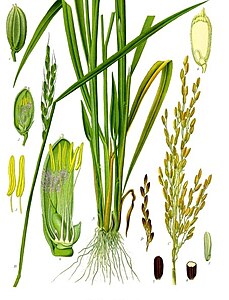
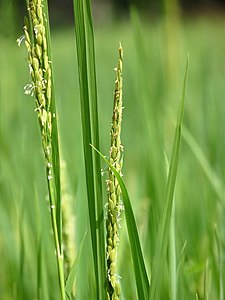

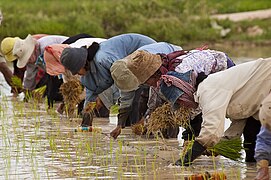


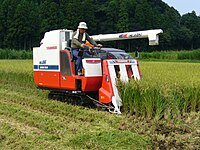
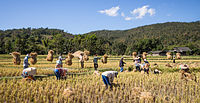

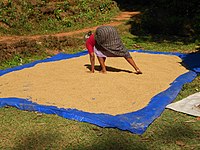
![Production of rice (2021)[35]](https://upload.wikimedia.org/wikipedia/commons/thumb/8/82/Production_of_rice_%282019%29.svg/500px-Production_of_rice_%282019%29.svg.png)


